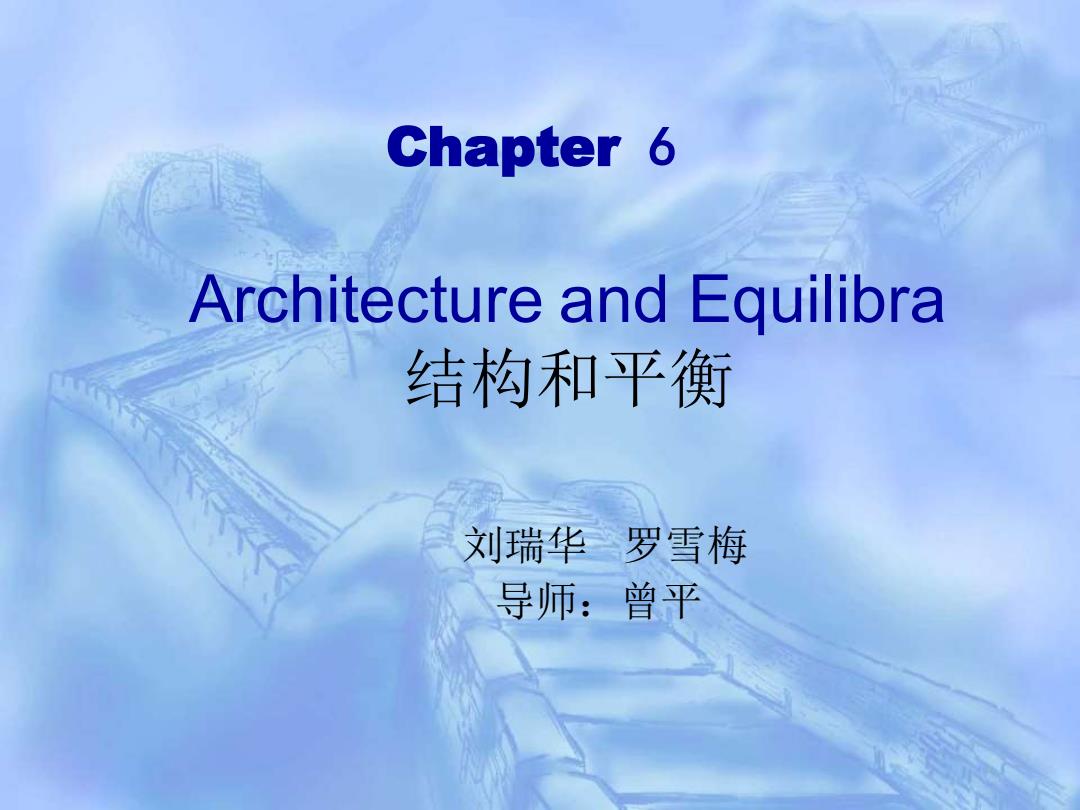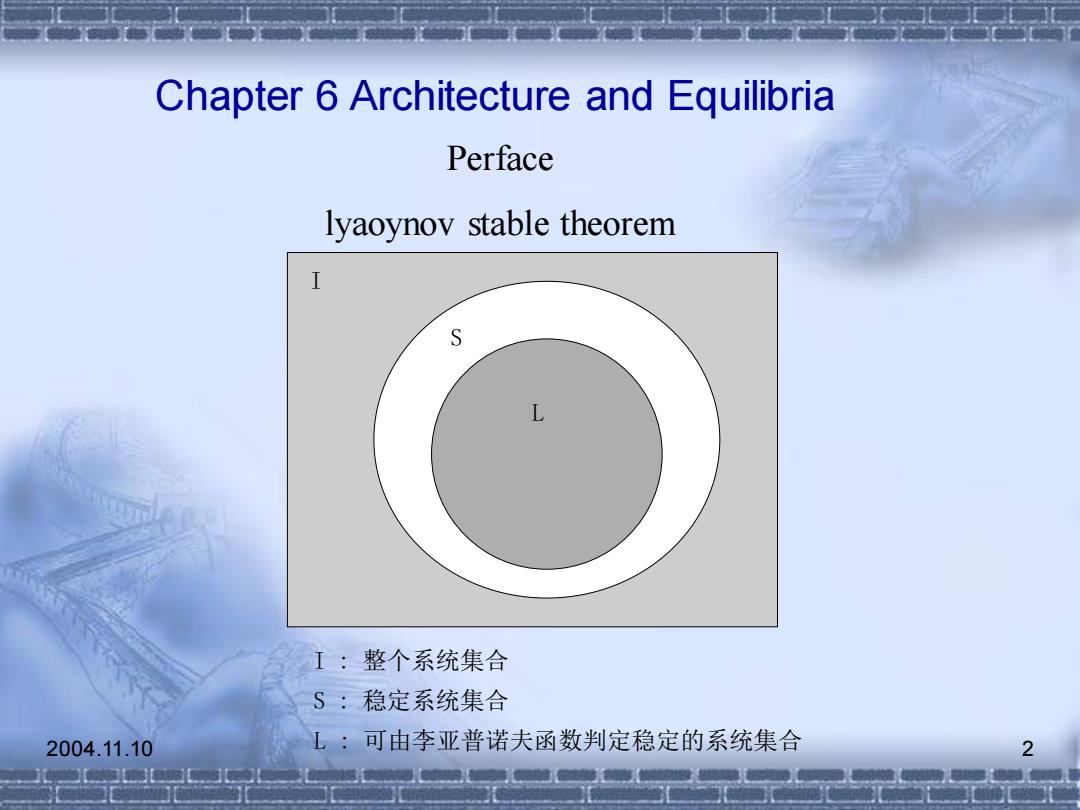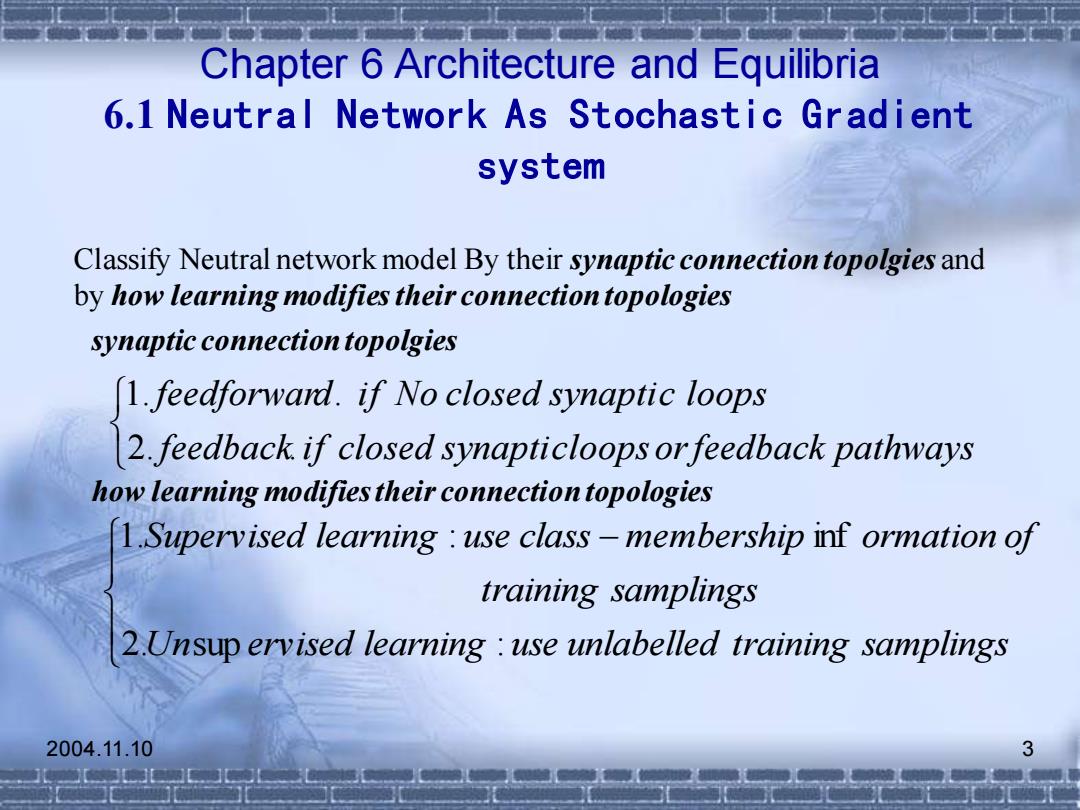
Chapter 6 Architecture and Equilibra 结构和平衡 刘瑞华罗雪梅 导师:曾平
Architecture and Equilibra 结构和平衡 刘瑞华 罗雪梅 导师:曾平 Chapter 6

Chapter 6 Architecture and Equilibria Perface lyaoynov stable theorem S L I:整个系统集合 S:稳定系统集合 2004.11.10 L:可由李亚普诺夫函数判定稳定的系统集合 2
2004.11.10 2 Chapter 6 Architecture and Equilibria Perface lyaoynov stable theorem I I S L I : 整个系统集合 S : 稳定系统集合 L : 可由李亚普诺夫函数判定稳定的系统集合

Chapter 6 Architecture and Equilibria 6.1 Neutral Network As Stochastic Gradient system Classify Neutral network model By their synaptic connection topolgies and by how learning modifies their connection topologies synaptic connection topolgies 1.feedforward.if No closed synaptic loops 2.feedback if closed synapticloops orfeedback pathways how learning modifies their connection topologies 1.Supervised learning use class-membership inf ormation of training samplings 2.Unsup ervised learning use unlabelled training samplings 2004.11.10 3
2004.11.10 3 Chapter 6 Architecture and Equilibria 6.1 Neutral Network As Stochastic Gradient system Classify Neutral network model By their synaptic connection topolgies and by how learning modifies their connection topologies feedback i f closed synapticloops orfeedback pathways feedforward i f No closed synaptic loops 2. . 1. . − Un ervised learning use unlabelled training samplings training samplings Supervised learning use class membership ormation of 2. sup : 1. : inf synaptic connection topolgies how learning modifies their connection topologies

Chapter 6 Architecture and Equilibria 6.1 Neutral Network As Stochastic Gradient system Decode Feedforward Feedback s三C刀 Gradiedescent LMS Recurrent BackPropagation BackPropagation =t可 Reinforcement Learing Vetor Quantization RABAM Broenian annealing Self-Organization Maps ABAM Competitve learning ART-2 Counter-propagation BAM-Cohen-Grossberg Model Hopfield circuit Brain-state-In Box Adaptive-Resonance ART-1 ART-2 2004.11.10 Neural NetWork Taxonomy
2004.11.10 4 Chapter 6 Architecture and Equilibria 6.1 Neutral Network As Stochastic Gradient system Gradiedescent LMS BackPropagation Reinforcement Learing Recurrent BackPropagation Vetor Quantization Self-Organization Maps Competitve learning Counter-propagation RABAM Broenian annealing ABAM ART-2 BAM-Cohen-Grossberg Model Hopfield circuit Brain-state-In_Box Adaptive-Resonance ART-1 ART-2 Feedforward Feedback Decode d e s i v r e p u S d e s i v r e p u s n U e d o c n E Neural NetWork Taxonomy

Chapter 6 Architecture and Equilibria 6.1 Neutral Network As Stochastic Gradient system Three stochastic gradient systems represent the three main categories: 1)Feedforward supervised neural networks trained with the backpropagation(BP)algorithm. 2)Feedforward unsupervised competitive learning or adaptive vector quantization(AVQ)networks 3)Feedback unsupervised random adaptive bidirectional associative memory(RABAM)networks. 2004.11.10 5
2004.11.10 5 Chapter 6 Architecture and Equilibria 6.1 Neutral Network As Stochastic Gradient system ▪ Three stochastic gradient systems represent the three main categories: 1)Feedforward supervised neural networks trained with the backpropagation(BP)algorithm. 2)Feedforward unsupervised competitive learning or adaptive vector quantization(AVQ)networks. 3)Feedback unsupervised random adaptive bidirectional associative memory(RABAM)networks